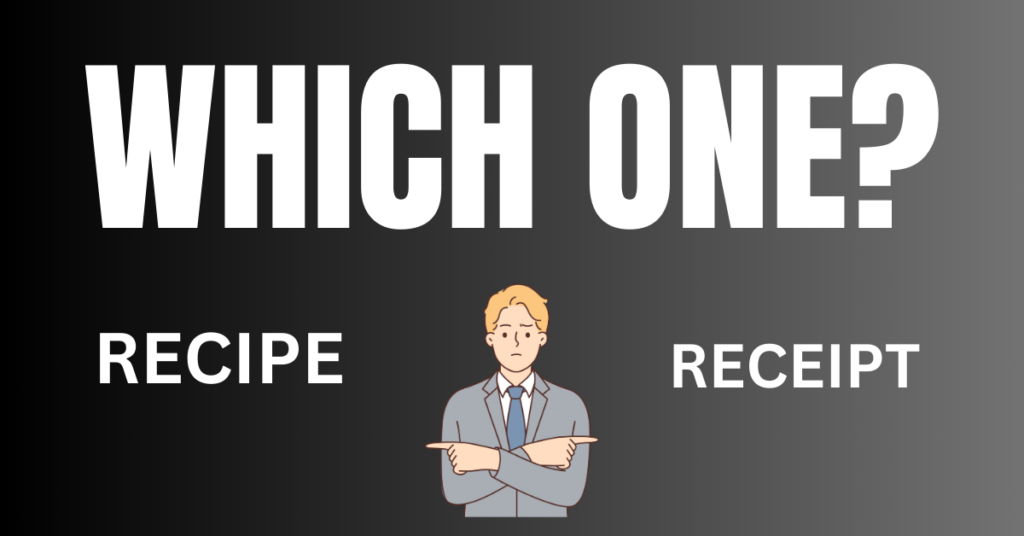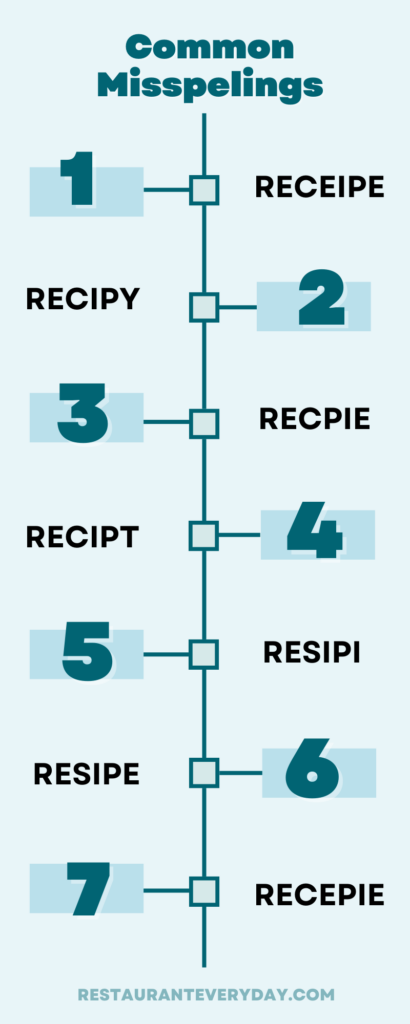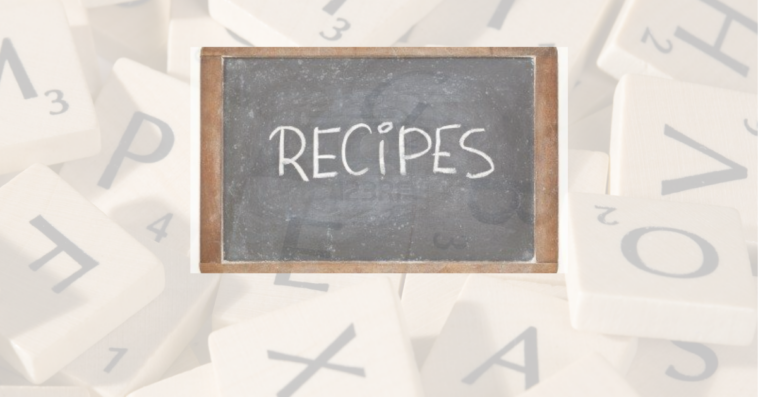Recipe is the pet phrase of almost everyone of us these days. We have to have some recipe to follow if we want to create some magic. And our best resort for this search is google. But at times we mess up the spellings so How do you spell recipe? You might find this question absurd but there are some folks who often get confused with these spellings.
English linguistics has never been merciful to its users. The complexities of words and usages has always been nerve wrecking. Similarly there is a whole story of evolution behind the origin of the word ‘recipe’. From its spellings to how to pronounce the word recipe, every scene of the story is covered.
In this article we will look into the linguistic analysis, origin, etymology, pronunciation and the most common misspelled versions of the word recipe. Let us dig in and make things easier for English users whether as native speakers or as a second language.
Related: How Do You Spell Restaurant?
How Do You Spell Recipe?
In the English language the term ‘recipe’ is a noun which means a set of instructions and guidelines to prepare a culinary creation or a particular dish. According to the English language spelling conventions the letters are arranged as R-E-C-I-P-E to spell the word.
Like most of the English vocabulary, the word recipe is derived from the Latin language. Initially, it was the word ‘recipere’ which further evolved into the current version i.e., recipe. The general meaning of this word is ‘ to receive’ or ‘to take’. Over time, the linguists made changes to the inspiration term and coined the word recipe mainly used for the cooking instructions or to state step-by-step procedural guidelines.
The English diction is like a magician’s hat withholding numerous ways to use a single word. Likewise, the word recipe extends beyond the cooking realm or the culinary field. It is often used in other dimensions of daily life like professions and actions. For instance, recipe of success, or recipe to excel your business. It acts as an intriguing word for marketing purposes.
Hence, ‘recipe’ is not a monotonous term rather it has versatile linguistic usages. You can use this practical term in your daily life conversations and complex contexts as well with full confidence when you know how to use it efficiently and most importantly you know how to spell and pronounce it. So, be clear in How do you spell recipe?
Origin and etymology of the Word ‘Recipe’
The English language is highly indebted to the Latins as most of its words have their origin from the old Latin syntax. The usage of the word ‘recipere’ in Latin was quite broadened and generalized, so it could be used in any context that involved instructions and guidelines. However, this time the word recipe is an amalgamation of latin and french languages where the meaning conjoins at one place.
Medieval Latin and French Transition of Recipe
Progressing with time, we enter the medieval Latin and old French era where the meaning of recipere i.e. taking or receiving was all over the place. There was an eminent transition in the old French language: the word récipé was used by physicians to write medical prescriptions holding the recipe or the instructions for creating the dosage of medicine since the 15th century. So, the confusion is nothing new to the world.
The old classical, neo classical and medieval latin along with Anglo-French and Old North French times have their specific versions of recipe’s origin. The word ‘receit’ which means the act of receiving from the Anglo French in 1400 C was used as an inspiration for the words like receipt and recipe.
Moreover, the spellings have been evolving ever since the classical and medieval latin era. The classic letter ‘p’ as in Latin ‘recepta’ has been fairly restored in the English transitions. For instance, the word carrying the same meaning of ‘to hold’, ‘to take’, ‘to receive’ is attributed to the word ‘receipt’ and with origination it became recipe.
Recipe or Receipt : From Medical to Culinary

You would be highly fascinated by the fact that the current term ‘recipe’ has traversed from the medical realm to the culinary world. Many of us would be intrigued with this linguistic evolution but it is how the evolution of life seems. You might find it difficult to grasp that at one time the recipe was all about pharmaceutical purposes.
In the early 15h century the physicians or the health care providers would write prescriptions as in : Recipe : Take 2 full spoons twice a day etc. Do not feel alien to this word because there is a contextual relationship between recipe, receipt or prescriptions.
Back in time mostly the doctors would custom make the medicines for every individual patient. For this reason, they had to write a proper set of instructions : recipe for the medications. It was only after the mid 20th century that the pharmacies got hold of mass-produced drugs that could be prescribed by physicians generally.
The shift of the word recipe to the culinary context is a prime example of the language adaptability which the English language is known for. In earlier times, cooking dishes was never documented or measured; it was all about daily routine practices. However, with time things changed and people started being more particular about the use and quantity of the ingredients. That is how cookbooks were invented and most of them used the word receipt e.g. Carrot Cake Receipt.
The language experts and users have transformed it according to their needs and requirements like the cooking techniques were named and codified within the culinary art realm. Despite the constant traversion and evolution, the word recipe has retained its culinary meaning till date. Now when you hear the word recipe, it will only bang the door of the cooking compartment in your head whether you are a home cook or run a restaurant.
RECIPE OR RECEIPE : Common Misspellings
Culinary instructions need to be precise and concise, there is no room for mistakes. Similarly, the spellings of recipe demand precision. The correct spelling of the word is RECIPE. As we all know, the most used research tool is the internet. There you need to be specific and accurate to get the best results. That is why you must add the right spellings of the recipe to get the desired results whether you are looking for a Thai food recipe or a baking delight.
However, there is a common pitfall i,e., Receipe. This is a common error where an additional ‘e’ is inserted in the word. It usually happens due to the pronunciation of the word which makes the user feel that there should be an extra vowel in the word. This is where the conflict between spoken and written language appears, well that is another debate we’ll do some other time.
Thus, from daily conversations to cookbooks, to food blogs, the accuracy and precision of spellings ensure clear communication. Because one single letter could change the meaning and the whole process of cooking may be affected. However, following are a few of the commonly misspelled versions of the word ‘recipe’, so that you can know and avoid them in future. Remember the correct spelling is R-E-C-I-P-E, rest all are the illusions.

You will find yourself using any of these at least once in your life but we should never be ashamed of correcting ourselves and learning. Make sure now you use the right spelling next time searching for a restaurant like steak recipe on google.
How to pronounce the word Recipe?
Pronunciation is the crucial part of spoken language be it English or any other language. The regional dialect may affect the pronunciation but it stays pretty much the same according to the standard English language conventions. Following is a breakdown of how to pronounce the word recipe i.e., the phonemic transcription as per IPA standards, syllables, stressed and silent variables.
- Transcription: /resəpi/
- Syllables: There are 3 syllables : RES+ uh+ pee
- The stress is on the first syllable: RES-uh-pee.
- The “r” is pronounced as a soft sound, similar to a gentle tap of the tongue against the roof of the mouth.
- The “e” in the first syllable is pronounced as a short, open “e” sound.
- The “i” is pronounced as a short, lax “i” sound.
- The “p” is pronounced as a voiceless “p” sound.
- The final “e” is silent.
Using Memory Tricks To Spell Recipe
The cunning world has all the tricks and ways to ease the complexities. Mnemonics is yet another example of such tricks used to remember and spell the words correctly. There are many other ways as well that you can use to better your vocabulary and memory in terms of spelling the words.
Mnemonics carries the mantle when it comes to breaking down the difficult words to remember their spellings. For instance, you can make a fun phrase like ‘Remember Every Culinary Instruction Pretty Ester’, you can use the first letter of each word in the phrase to spell the word ‘RECIPE’.
Moreover, the aloud pronunciation and repetitive writing of the spelling can also help you retain the information. While the phonemic breakdown can also be helpful in memorizing the correct spellings of the word.
Conclusion : Mastering the Spelling of Recipe
We are sold that “Recipe” is a crucial term in the culinary world, with its correct spelling, R-E-C-I-P-E, deeply rooted in Latin origins. The evolution from Latin imperative to its role in medieval medicine to its current culinary context highlights language’s adaptability. Regardless of the regions around the globe, every cuisine definitely has its recipes be it American, Indian, Mexican or Chinese cuisine.
Precision is essential, especially in internet searches. Beyond cooking, the term extends metaphorically, emphasizing its versatility. Memory tricks, including mnemonics, aid in mastering the correct spelling, ensuring effective communication. In exploring the linguistic journey of “recipe,” we are all praise for its rich history and enduring role in guiding us through the world of cooking and linguistic evolution. We hope now you are clear on how do you spell recipe?
People also read: How to Freeze Dry Food?




